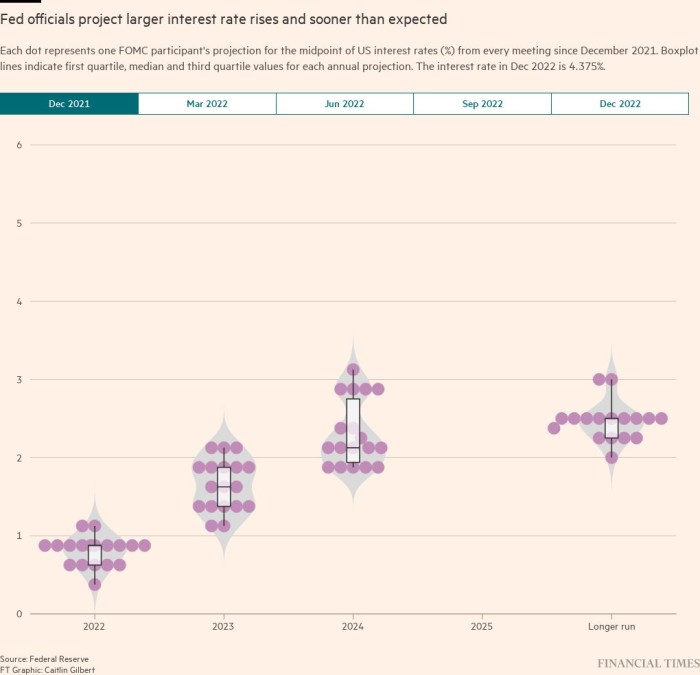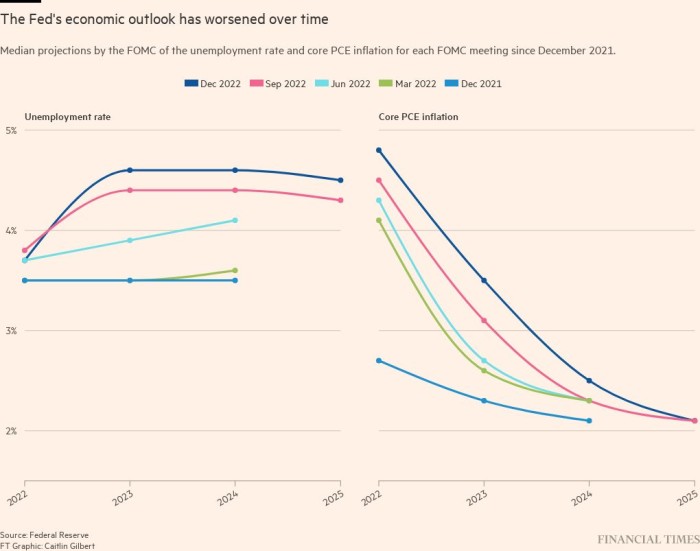[ad_1]
Persistently high US inflation will be difficult to squelch after taking root in the services sector of the economy, economists warn, suggesting the Federal Reserve will be forced to press ahead with further interest rate rises in 2023.
After a year of skyrocketing consumer prices, the US inflation rate is poised to decline rapidly next year. But many economists caution underlying pressures will keep it at levels well above what the Fed considers palatable.
“The risk of confusion here is that this is going to sound on the one hand like massive progress and it’s going to feel like maybe we can relax,” said Jean Boivin, the former deputy governor of the Bank of Canada who now heads up the BlackRock Investment Institute. “But those numbers at the end of year will be nowhere near the zip code of [what] the Fed will be comfortable with.”
The US central bank has aggressively raised interest rates this year in an attempt to stamp out high inflation. But its task has become trickier because of a divergence between price trends for good and for services.
Inflation tied everyday goods such as furniture, used cars and appliances is in decline. Prices for such items had soared early in the pandemic as demand surged and manufacturing and shipping were disrupted. Recent data suggest the trend has started to reverse and is likely to continue in 2023 as retailers mark down bloated inventories.
Housing costs are also likely to cool, economists say. Surging mortgage rates linked to the Fed’s rate rises have pushed down home prices. New leases for rental properties are off their recent peaks, with asking rents registering the largest monthly drop in the seven years since real estate company Zillow began tracking the data.
Taken together, most Fed officials expect the personal consumption expenditures price index — once volatile food and energy costs are stripped out — to fall to an annual rate of 3.5 per cent next year. Economists surveyed by Bloomberg forecast core PCE inflation will moderate to about 3 per cent by the fourth quarter of next year.
Both projections remain well above the Fed’s 2 per cent target. In November the core PCE index rose 4.7 per cent on an annual basis, according to data released on Friday, slowing from a peak of 5.4 per cent earlier this year but higher than the Fed’s target.
Offsetting declining goods inflation are costs from dining out, haircuts, commuting and other activities tied to the services sector — a dynamic that Fed chair Jay Powell warned about at his final press conference of 2022.
“Goods inflation has turned pretty quickly now after not turning at all for a year and a half,” he said after the Fed’s December monetary policy meeting, at which the central bank slowed down the pace of its interest rate increases and raised its policy rate to a new target range of 4.25 per cent to 4.5 per cent. “But there’s an expectation that the services inflation will not move down so quickly, so that we’ll have to stay at it [and] we may have to raise rates higher to get to where we want to go.”
How persistent services inflation turns out to be depends chiefly on the labour market. Amid a worker shortage and buoyant consumer demand, employers have had to boost pay and benefits to keep pace. Compared to November of last year, wages are up 6.4 per cent, data from the Atlanta Fed show.
Fed officials have conceded its efforts to bring down inflation will involve job losses, but they maintain a recession can be avoided. Most officials expect the economy to expand just 0.5 per cent next year and for the unemployment rate to rise nearly a full percentage point to 4.6 per cent.
“What they’re trying to do is cool inflation faster than they cool wages,” Diane Swonk, chief economist at KPMG, said of the Fed.
Swonk expects the economy to tip into a recession next year while inflation declines to just under 3 per cent by the end of 2023. The prospect of being blamed for job losses puts the Fed “in this horrible position of having to look like it’s against the labour market”, she said.
Officials maintain they can get inflation under control by raising the benchmark federal funds rate to between 5 per cent and 5.25 per cent next year and maintaining that level at least through 2024 — a view that is at odds with current market pricing, which suggests the central bank will not have to lift its policy rate above 5 per cent and will deliver roughly two rate cuts by the end of next year.
Powell has also warned the Fed may need to be even more aggressive if the data do not co-operate, given their unwavering commitment to get inflation back down. One concern is the potential impact from China reversing its zero-Covid policy, which some economists warn may unleash another round of commodity price increases.
“Without price stability, you’ve got nothing,” said Stephen Cecchetti, an economist at Brandeis University who previously led the monetary and economic department at the Bank for International Settlements. “You don’t have general economic stability and prosperity. You don’t have financial stability. You’ve just got chaos.”
[ad_2]
Source link


